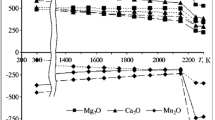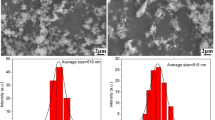Abstract
Published data and research results are used in raising the thermal stability of silicon carbide and molybdenum disilicide electric heaters.
Similar content being viewed by others
References
All-Union State Standard 16139-76: Silicon Carbide Heaters for Resistance Ovens: Implemented 01.06.82 [in Russian].
Technical Specification 16-531-140-76: High-Temperature Heaters Made of Molybdenum Silicide, Type SM-1. Implemented 01.01.76 [in Russian].
P. S. Kislyi, A. Kh. Badyan, V. S. Kindysheva, and F. S. Garibyan, High-Temperature Nonmetallic Heaters [in Russian]. Naukova Kumka, Kiev (1981), 166 pp.
Tsuchikata Kenichi, Submission 58-237241 Japan: A High-Strength Sintered Silicon Carbide Material. Published 13.07.85.
Mahamed N. Rahaman, “Surface characterisation of silicon nitride and silicon carbide powders,” Amer. Ceram. Soc. Bull., No. 8, 1171–1176 (1986).
A. P. Podoba, L. S. Golubyak, V. G. Kulich, and T. D. Ositinskya, “Microstructure and physicomechanical properties of a silicon carbide ceramic,” Sverkhtverdye Materialy, No. 6, 18–20 (1988).
L. M. Buchatskii, Sh. N. Nadriin, and A. M. Nagnii, “Compaction kinetics and rheological properties of materials based on molybdenum disilicide at high temperatures,” In: Silicides and their Uses in Engineering [in Russian]. Inst. Probl. Materialovedeniya AN Ukrainy, Kiev (1990), pp. 55–58.
S. V. Vedeneev, N. N. Zhilyaeva, L. S. Stel'makh, et al., “Research on technological modes of HTS-extrusion for high-temperature heating elements based on MoSi2,” Ibid., In: pp. 59–63 [in Russian].
J. Kriegesmann, “Sintering phenomena in silicon carbide,” Powder Met. Int., No. 5, 341–343 (1986).
Negita Keishi, “Effective sintering aids for silicon carbide ceramics. Reactivities of silicon carbide with various additives,” J. Amer. Ceram. Soc., No. 2, 308–210 (1986).
Kijima Ichitomo and Abe Masayuki, Submission 61-103484 Japan: A High-Density Sintered Material Based on Silicon Carbide and a Method of Making it. Publ. 13.11.87.
Yasutomi Ioshiyuki, Submission 61-101465 Japan: A method of Making a Silicon Carbide Ceramic. Publ. 20.05.86.
Saito Hizo and Yamakawa Shirakawa Hiroshi, Submission 62-21762 Japan: A Silicon Carbide Refractory. Publ. 30.01.87.
Furukawa Minihiko, Submission 60-231466 Japan. High-Density Sintered Silicon Carbide. Publ. 18.11.85.
E. Kostic, “Sintering of silicon carbide in the presence of oxide additives,” Powder Met. Int., No. 6, 28–29 (1988).
M. Billy, “Comportement des ceramiques en atmosphères oxydantes,” Mater. Sci. Eng., No. 88, 53–60 (1987).
Mark A. Janney, “Oxidation of SiC matrix composites,” Ceram. Eng. Sci. Proc., No. 7/8, 714 (1985).
Donglang Jiang, Gao Kuang, and Zhensu Pan, “Oxidation behavior and high-temperature strength of hot-pressed SiC with various sintering aids,” High Technical Ceramics, Amsterdam (1987), pp. 1149–1158.
Takehashi Ken, “Effect of uniformity on the electrical resistivity of SiC-ZrB2 ceramic composites,” J. Amer. Ceram. Soc., No. 12, 369–379 (1987).
Stuart Maloy, Arthur H. Heuer, and John Zewandowski, “Carbon additions to molybdenum disilicide: improved high-temperature mechanical properties,” Ibid., No. 10, 2704–1706 (1991).
“Molybdenum silicide-titanium diboride composite ceramics,” New Materials Development, pp. 127–129 (1987).
“Verbundkeramiken aus SiC Feuerfestmaterial,” Osterr. Keram. Rund., No. 5–6, 8–10 (1986).
Kamijo Eiji, Higuchi Matsuo, and Komura Osamu, Pat. 4753764 USA. Manufacturing Method for Fiber-Reinforced Silicon Ceramics Sintered Body. Publ. 28.06.88.
P. F. Becher and T. N. Tiegs, “Toughening behavior involving multiple mechanisms: Whisker reinforcement and zerconia toughening,” J. Amer. Ceram. Soc., No. 9, 651–654 (1987).
P.-J. Lamicq, “Les ceramique/ceramique,” Mec. Mater. Elec., No. 412, 11–14 (1985).
W. S. Gibbs, “SiC whisker-MoSi2 matrix composites,” Ceram. Eng. Sci. Proc., 645–648 (1987).
Arum K. Battacharya and John J. Petrovic, “Hardness and fracture toughness of SiC-particle-reinforced MoSi2 composites,” J. Amer. Ceram. Soc., No. 10, 2700–2703 (1991).
Krishan L. Luthra, “Oxidation of SiC-containing composites,” Ceram. Eng. Sci. Proc., No. 7–8, 649–653 (1987).
H.-D. Tietz and H. Schwarz, “Korrosions-verhalten von Maschinenbaukeramik,” Silikattechnik, No. 4, 120–123 (1989).
J. Li and P. Eveno, “Oxidation of SiC,” Werkst. Und Korros., No. 12, 716–725 (1990).
H. Holleck, “Basic principles of specific applications of ceramic materials at protective layers,” Surface Coat. Technol., No. 1–3, 245–258 (1990).
USA Patent 2003592. Glaze for Nonmetallic Resistors, E. Hediger. Publ. 04.06.35.
W. Epprecht and F. Held, USA Patent 2993814. Heating Conductor and Method of Making the Same. Publ. 25.07.61.
C. G. Rose and J. C. Andersen, USA Patent 3252827. Refractory Carbide Bodies and Method of Making Them. Publ. 24.05.66.
G. Lax, Patent 1048265 Great Britain: A Silicon Carbide Heating Element. Publ. 06.11.66.
G. V. Samsonov and P. S. Kislyi, Authors' Certificate 133960 USSR: A Carboruandum Heater. Otkrytiya, Izobret., No. 23, 102 (1960) [in Russian].
R. R. Giler, “High temperature electric furnaces with MoSi2 heating elements,” Metal. Eng. Quart., No. 4, 48–52 (1979).
N. A. Schrewelins, Patent 204116 Sweden. Satt all Framstalla Sintrade Kroppar Sasom Elektriska Upphettningselement Huvudsakligen Bestaende av MoSi2. Publ. 03.05.66.
Additional information
Ternopol Pedagogic Institute. Translated from Poroshkovaya Metallurgiya, Nos. 11–12(382), pp. 68–73, November–December, 1995.
Rights and permissions
About this article
Cite this article
Dzyadikevich, Y.V., Bochar, I.I. Ways of raising the thermal stability of electric heaters based on silicon carbide and molybdenum disilicide ceramics. Powder Metall Met Ceram 34, 650–654 (1996). https://doi.org/10.1007/BF00559496
Received:
Issue Date:
DOI: https://doi.org/10.1007/BF00559496




